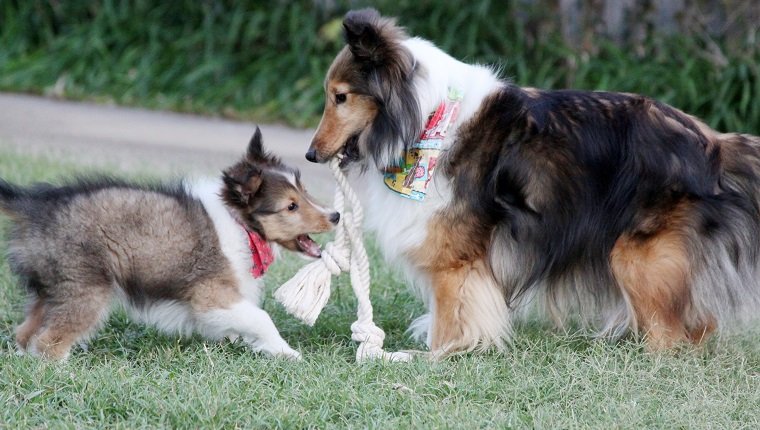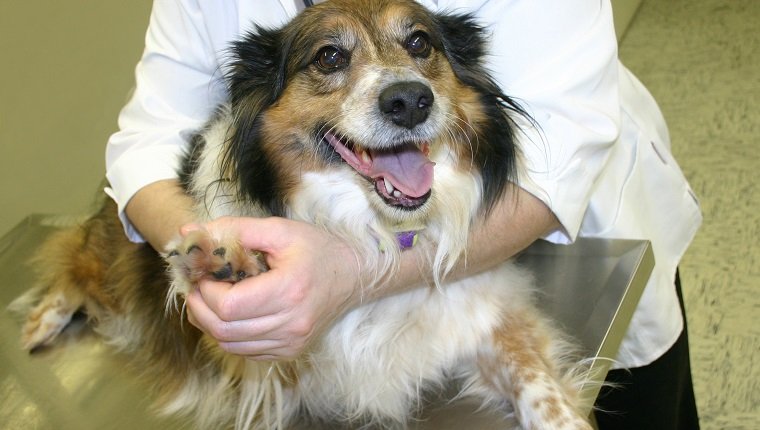Dermatomyositis in dogs is a hereditary, immune-mediated disease that affects the skin and, sometimes, the muscles and blood vessels. The disease is most common in Collies, Shetland Sheepdogs, and mixes of those breeds. It mostly affects young dogs, though it can develop in adult dogs, as well.
Symptoms include inflammation and skin lesions that usually appear before dogs turn six months old, sometimes as early as seven weeks after birth. When the condition develops early in life, it’s usually more severe than when it appears during adulthood.
Lesions can vary in intensity and increase or decrease over time. In severe cases, dogs may suffer from muscle atrophy, stunted growth, lameness, an enlarged esophagus, and sores all over the face, paws, and tail.
If you see the signs in your dog, consult your veterinarian so they can form a proper diagnosis and prescribe treatment that may provide some relief from symptoms. Here’s what you should know about the symptoms, causes, and treatments for dermatoyositis in dogs.
Symptoms Of Dermatomyositis In Dogs

The symptoms of dermatomyositis in dogs can vary a great deal between canines and even between puppies of the same litter. Additionally, these symptoms may increase and decrease over time.
Some dogs develop mild signs that can clear up on their own and require very little treatment, while others need hospitalization.
Here are some of the symptoms that can develop in dogs who suffer from dermatomyositis:
- Lesions on the face (on the nose, around the eyes, on the tips of the ears)
- Lesions on the tip of the tail
- Ulcers on the foot-pads
- Loss of nails
- Stiff or uneven gait
- Ulcers in the mouth
- Crusting, scaling skin
- Dandruff
- Alopecia (hair loss)
- Inflammation and redness of the skin
- Difficulty eating, drinking, or swallowing
- Aspiration pneumonia (due to enlarged esophagus)
- Muscle atrophy, especially around the head, face, or jaw
- Secondary skin infections
Causes Of Dermatomyositis In Dogs

The main cause of dermatomyositis in dogs is inheriting the condition genetically, and it’s almost completely exclusive to Shetland Sheepdogs, Collies, and mixes of those breeds.
Other breeds have shown similar symptoms, but these dogs usually suffer from a condition called ischemic dermatopathy, which is a low blood supply to the skin. This is not the same condition as dermatomyositis.
Other causes for the disease include immune-mediated conditions and infectious agents. Chow Chows and Corgis have also been known to develop dermatomyositis, though it’s rare.
Treatments For Dermatomyositis In Dogs

Treatment for dermatomyositis in dogs is focused on managing the condition, as there is no outright cure. Usually dogs who suffer from the condition are treated as outpatients or treated at home.
Pet parents should limit activity that could cause injury to the affected skin or muscle, and they should also limit exposure to ultraviolet light. It’s best if affected dogs stay out of the sunlight as much as possible.
Dogs who have trouble chewing or swallowing, may need changes in diet and the way that they’re fed. Dog parents may need to soften food or feed their dogs by hand.
If your dog suffers from dermatomyositis, your vet will tell you how to tailor your dog’s feeding habits to address their individual condition. If a dog suffers from an enlarged esophagus, they may need hospitalization and supportive care.
Hypoallergenic shampoos can help fight some secondary skin infections. Anti-inflammatory medication can reduce some inflammation, though long-term exposure to these medications can cause harmful side effects. Often, lesions come and go on their own and may just require monitoring, rather than veterinary treatment.
Do you have a dog who suffers from dermatomyositis? How do you manage their condition? Let us know in the comments below!




